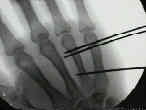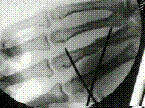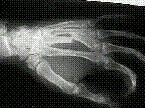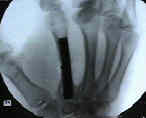- Treatment Options:
- percutaneous pinning w/ 1.6 mm or 2.00 m K wires in small fragments;


- ref:
Complications of smooth pin fixation of fractures and dislocations in the hand and wrist.
Absorbable intramedullary implants for hand fractures. Animal experiments and clinical trial.
- screw fixation:
- 2.0 mm or 2.7 mm cortex screws as lag screws in spiral frx;
- 2.0 mm screws are applied to the cortex and the 2.7 mm screws are applied to the metaphysis;
- screws should be countersunk to remove prominent head and to improve loading characteristics;
- generally two screws are required for metacarpal shaft fractures;
- note: the drilling into small bones does have an effect of torsional rigidity;
- drilling a hole more than 30% of the shaft diameter, leads to a 90% reduction in torsional rigidity;
- plate fixation:
- indicated for multiple metacarpal shaft frx, or other unstable shaft fractures that cannot be help reduced w/ K wires or screws;
- overlying soft tissues must be intact for plate fixation;
- in absence of comminution & intact palmar cortex, one quarter tubular plate w/ 2.7 mm screws is adequate;
- this will allow plate to function as a tension band plate;
- w/ comminution, use stronger implant such as 2.7 mm DCP & consider bone grafting;
- plates must be placed on the dorsal surface inorder to function as a tension band;
- quater tubular plate or 2.7 mm DCP as neutralization plate, especially in lag screw fixation of second to fifth metacarpals, esp w/ spiral fractures with rotational displacement;
- w/ segmental defects or comminution a 2.7 mm DCP is required;
- prebending of the plate slightly beyond the normal metacarpal bow allows restoration of the anterior cortical butress;
- references:
Unstable metacarpal and phalangeal fracture treatment with screws and plates.
Rigid internal fixation in the hand: 104 cases.
Rigid fixation of phalangeal and metacarpal fractures.
Use of a minicondylar plate for metacarpal and phalangeal periarticular injuries.
Complications of plate fixation in the hand skeleton.
- surgical approach: (plate fixation)
- see: extensor anatomy;
- longitudinal incision made either between on the outer border of the metacarpals;
- border metacarpals are approached thru longitudinal incisions between 2nd and thrid or fourth and fifth metacarpals;
- juncturae tendinum interconnecting the common extensor tendons can be split to enhance exposure (tag for later repair);
- proximally the incision may be curved to expose the CMC joints;
- if the metacarpal head needs to be exposed the extensor mechanism may be split down the middle or may be entered thru the radial saggital band;
- the radial side offers better exposure to the joint than the ulnar side;
- carefully incise thru the intrisic fascia inorder to preserve an optimal gluiding mechanism;
- external fixation of metacarpal fractures:
- indicated for crush, mangling, or burn injuries which occur along w/ metacarpal fractures;
- often used in conjunction w/ soft tissue reconstructive procedures;
- references:
Manipulation and external fixation of metacarpal fractures.
External fixation of unstable metacarpal and phalangeal fractures.
External fixation of metacarpal and phalangeal fractures.
Treatment of hand injuries by external fixation.




